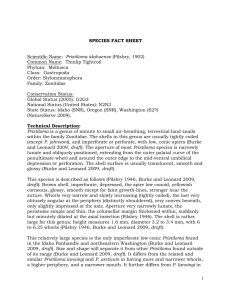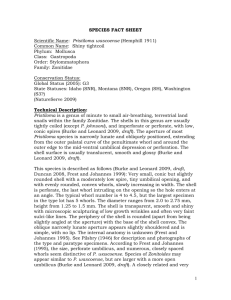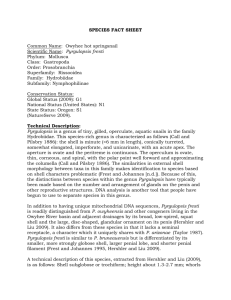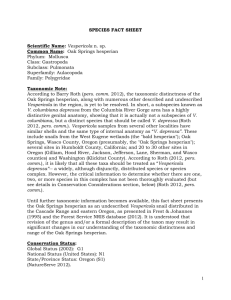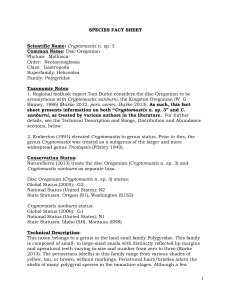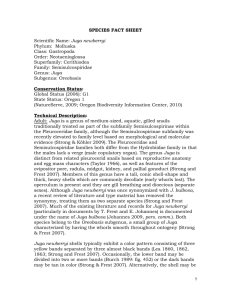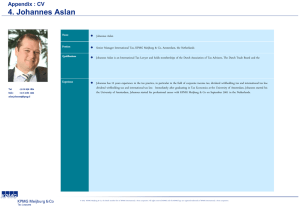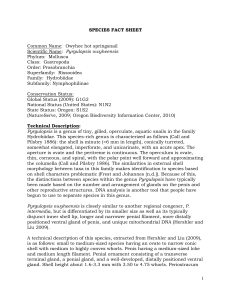SPECIES FACT SHEET - USDA Forest Service
advertisement
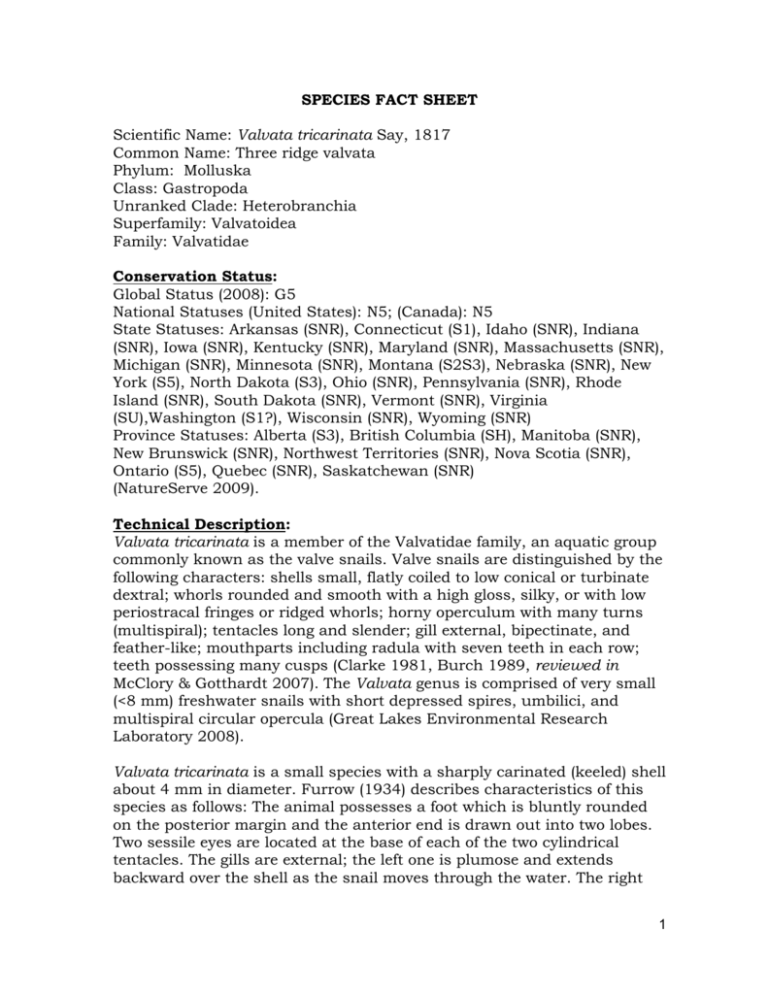
SPECIES FACT SHEET Scientific Name: Valvata tricarinata Say, 1817 Common Name: Three ridge valvata Phylum: Molluska Class: Gastropoda Unranked Clade: Heterobranchia Superfamily: Valvatoidea Family: Valvatidae Conservation Status: Global Status (2008): G5 National Statuses (United States): N5; (Canada): N5 State Statuses: Arkansas (SNR), Connecticut (S1), Idaho (SNR), Indiana (SNR), Iowa (SNR), Kentucky (SNR), Maryland (SNR), Massachusetts (SNR), Michigan (SNR), Minnesota (SNR), Montana (S2S3), Nebraska (SNR), New York (S5), North Dakota (S3), Ohio (SNR), Pennsylvania (SNR), Rhode Island (SNR), South Dakota (SNR), Vermont (SNR), Virginia (SU),Washington (S1?), Wisconsin (SNR), Wyoming (SNR) Province Statuses: Alberta (S3), British Columbia (SH), Manitoba (SNR), New Brunswick (SNR), Northwest Territories (SNR), Nova Scotia (SNR), Ontario (S5), Quebec (SNR), Saskatchewan (SNR) (NatureServe 2009). Technical Description: Valvata tricarinata is a member of the Valvatidae family, an aquatic group commonly known as the valve snails. Valve snails are distinguished by the following characters: shells small, flatly coiled to low conical or turbinate dextral; whorls rounded and smooth with a high gloss, silky, or with low periostracal fringes or ridged whorls; horny operculum with many turns (multispiral); tentacles long and slender; gill external, bipectinate, and feather-like; mouthparts including radula with seven teeth in each row; teeth possessing many cusps (Clarke 1981, Burch 1989, reviewed in McClory & Gotthardt 2007). The Valvata genus is comprised of very small (<8 mm) freshwater snails with short depressed spires, umbilici, and multispiral circular opercula (Great Lakes Environmental Research Laboratory 2008). Valvata tricarinata is a small species with a sharply carinated (keeled) shell about 4 mm in diameter. Furrow (1934) describes characteristics of this species as follows: The animal possesses a foot which is bluntly rounded on the posterior margin and the anterior end is drawn out into two lobes. Two sessile eyes are located at the base of each of the two cylindrical tentacles. The gills are external; the left one is plumose and extends backward over the shell as the snail moves through the water. The right 1 gill is a rudimentary structure forming a slender finger-like appendage which protrudes from the shell opening when the animal is extended. The reproductive system of this hermaphroditic species is composed of a single ovotestis and the hermaphrodite duct which separates into an oviduct and a spermiaduct leading into the female and male copulatory organs, respectively. The sperm duct after receiving a duct from the prostate enters the penis as the vas deferens. The oviduct leads into the receptaculum seminis (bursa copulatrix). The oviduct from the bursa copulatrix joins a short vestibule which also receives ducts from the albumen gland and the shell gland. The vestibule terminates in the external female genital aperture. Detailed illustrations of these features is provided in Furrow (1934). Multiple forms (= morphs) exist for this species, although none of them have been elevated to specific or subspecific level (Burch 1989, Frest & Johannes 1995). Detailed shell characteristics are available in Burch (1989). Frest and Johannes (1995) note that specimens from the Washington and Montana populations need to be compared in detail with more easterly occurrences, in view of the fact that speciation has occurred in several other genera with disjunct eastern and western representation. Egg mass: The eggs of this species are small structures measuring only 0.25 mm by 0.37 mm (Furrow 1934). Four to eighteen eggs (average ten) are deposited at a time in gelatinous capsules which are greenish in color (Furrow 1934). Life History: Although most cold water snails have single-year life spans, members of the Valvata genus may sometimes live for two years (Frest & Johannes 1995). The breeding season begins early in the summer and continues until late in August (Furrow 1934). If the animals are transferred from the lake to aquaria, the normal egg laying habits are suppressed for a period of three to four days, after which deposition of eggs is resumed and continues for many weeks. The time required for development of the eggs under conditions of the lake habitat is fifteen days during July and August, although in laboratory settings, egg development usually occurs in twelve days (Furrow 1934). Complete development from fertilization of the egg to adult maturity (attainment of typical 4 mm shell size) may be completed within four months, although a considerably longer time may be required under less favorable conditions. Self fertilization evidently does not occur, since 63 snails kept in isolation failed to reproduce, while reproduction occurred normally in every jar containing two or more individuals (Furrow 1934). No early mortality or nutritive cannibalism has been observed in the natural environment or in the laboratory (Furrow 1934). 2 Range, Distribution, and Abundance: Primarily a Mississippi drainage and Atlantic species, V. tricarinata is widely distributed across North America and Canada with most sites in the eastern areas of the continent (Taylor & Bright 1987; Frest & Johannes 1995; NatureServe 2009). This species is quite rare in the western United States, where most habitat is occupied by V. humeralis (Frest & Johannes 1995). The original distribution is listed as “Quebec and New Brunswick west to Alberta and south to Wyoming, Arkansas, and Virginia” (Burch, 1989). More recently, the species has been found in several lakes in the Clark Fork and Flathead drainages, Montana (Frest & Johannes 1995). In Washington, it is known from Lake Roosevelt (Columbia River) on the Stevens County side of the river (Burke 2010, pers. comm.). It has also been documented from three sites in the “Columbia River Drainage,” Ferry County, Washington, although the specific localities are unknown (Taylor & Bright 1987; Frest & Johannes 1995). Western occurrences of this species are strongly disjunct, as this species does not now occur in the Missouri headwaters (Taylor & Bright 1987; Frest & Johannes 1995). Likewise, searches in Idaho did not reveal this species (Frest & Johannes 1995). According to Burke (2010, pers. comm.), it is unclear why, or how, the species has shown up in the Columbia; it may be a native to the river, or a chance occurrence that has become temporarily established. BLM/Forest Service Land: This species is not documented from Forest Service or BLM lands in Oregon or Washington. The Spokane BLM District considers it suspected, due to the proximity of BLM lands to the known sites. It is documented from Washington Bureau of Reclamation reservoirs (Lake Roosevelt site) (Frest & Johannes 1995). It is also known from public lands in other states, including the Flathead Indian Reservation in Montana (Frest & Johannes 1995) and Cuyahoga Valley National Park in Ohio (Smith et al., 2002). Abundance: Although seldom recorded, this species can be quite abundant where it occurs, and populations are presumably large (NatureServe 2009). Habitat Associations: The valvatidae family is a primitive, holarctic group, basal to many other clades and with both marine and freshwater representation. This species occurs in a variety of permanent or perennial lake-like habitats, including portions of larger rivers (Frest & Johannes 1995). It is generally found in clear, cool-cold water on soft substrates. A grazer/filter-feeder, this species is frequently associated with submerged vegetation and generally occurs in areas with Chara, Myriophyllum, Ceratophyllum, and other macrophytes 3 (Frest & Johannes 1995). In kettle lakes, this species is very abundant on marl substrates, often up to considerable depths (Frest & Johannes 1995). Egg cases of this species have been found attached to various aquatic plants (e.g. Potamogeton, Chara, and Sagittaria species) and to floating objects (sticks and empty shells of other Valvata) (Furrow 1934). Threats: Modification, poisoning, and eutropification of kettle lakes pose threats to this species (Frest & Johannes 1995). In particular, nutrient enhancement due to farm animal wastes, sewage, or to irrigation runoff may so eutropify lakes as to exclude this species. Most kettle lakes in its western U.S. range have been so affected, or have been made part of irrigation systems (Frest & Johannes 1995). Major threats at the Washington sites (Lake Roosevelt) include the drawdown of the Columbia River each spring, toxic effluents, and habitat modifications such as vegetation changes (Burke 2010, pers. comm.). Conservation Considerations: Inventory: This species has a wide range but is rare in the Pacific Northwest and is probably declining due to range loss (Frest & Johannes 1995). More work is needed to determine the species' current status in Washington, Idaho, and Montana, and surveys at both new and known sites are suggested (NatureServe 2009, Frest & Johannes 1995, Burke 2010, pers. comm.). Additionally, specimens from older populations need to be rechecked and compared to determine if speciation has occurred, since there is a possibility that western populations of this species are morphologically distinct (Frest & Johannes 1995). Results from survey efforts will be valuable in evaluating the current status, range, population characteristics, and conservation needs of this species in the Pacific Northwest (Burke 2010, pers. comm.). Management: Until more is known about this species and its current distribution, consider monitoring and protecting known sites from any factors tending to downgrade water quality (NatureServe 2009, Burke 2010, pers. comm.). Manage new and known sites and their associated watersheds to reduce the impacts of recreational activity, urban development, water diversions, construction activities, and other practices that may adversely affect water quality. Riparian habitat protection, including maintenance of water quality, substrate conditions, and canopy cover, would likely benefit and help maintain this species. Prepared by: Sarah Foltz 4 Xerces Society for Invertebrate Conservation Date: June 2010 Edited by: Sarina Jepsen Xerces Society for Invertebrate Conservation Date: July 2010 Final Edits: Rob Huff FS/BLM Conservation Planning Coordinator Date: June, 2011 ATTACHMENTS: (1) References (2) List of pertinent or knowledgeable contacts (3) Map of Species Distribution in Washington (4) Photographs of Species (5) Aquatic Gastropod Survey Protocol, including specifics for this species ATTACHMENT 1: References: Burch, J. B. 1989. North American Freshwater Snails. Malacological Publications, Hamburg, MI, 365 pp. Burke, Tom. 2010. Personal communication with Sarah Foltz Jordan, Xerces Society. Clarke, A. H. 1981. The freshwater molluscs of Canada. National Museums of Canada, Ottawa, Ontaria. 446 pp. Deixis MolluscDB database. 2009. An unpublished collection of mollusk records maintained by Ed Johannes. Frest, T. J. and E. J. Johannes. 1995. Interior Columbia Basin mollusk species of special concern. Final report: Interior Columbia Basin Ecosystem Management Project, Walla Walla, WA. Contract #43-0E00-49112. 274 pp. plus appendices. Furrow, C. L. 1935. Development of the hermaphrodite genital organs of valvata tricarinata. Cell and Tissue Research 22(3): 282-304. Great Lakes Environmental Research Laboratory. 2008. Great Lakes Waterlife Photo Gallery: Valvatidae - valve snails. Available at: 5 http://www.glerl.noaa.gov/seagrant/GLWL/Benthos/Mollusca/Gastropod s/Valvatidae.html. (Last accessed 8 July 2010). McClory, J. G. and T. A. Gotthardt. 2007. Alaska Natural Heritatge Program Invertebrate Tracking List and Status Reports. Rams Horn Valvata: Valvata mergella. Alaska Natural Heritage Program. Environment and Natural Resources Institute, University of Alaska Anchorage, Anchorage, AK. Unpublished document. Available at: http://aknhp.uaa.alaska.edu/zoology/pdfs/invertebrates/Ramshorn_valvata.pdf (Last accessed 1 July 2009). NatureServe. 2009. “Valvata tricarinata”. Version 7.1 (2 February 2009). Data last updated: October 2009. Available at: www.natureserve.org/explorer (Accessed 1 June 2010). Smith, D. C., M. A. Gates, R. A. Krebs, and M. J. S. Tevesz. 2002. A survey of freshwater mussels (Unionidae) and other molluscs in the Cuyahoga Valley National Park. Ohio Biological Survey Miscellaneous Contribution, 8: 1-31. Strong, E. E. and T. J. Frest. 2007. On the anatomy and systematics of Juga from western North America (Gastropoda: Cerithioidea: Pleuroceridae). The Nautilus 121(2): 43-65. Taylor, D. W. and R. C. Bright. 1987. Drainage history of the Bonneville Basin. Pages 239–256. in Kopp, R. S. and R. E. Cohenour, editors. Cenozoic geology of western Utah sites for precious metals and hydrocarbon accumulations. Utah Geological Association Publication 16. Salt Lake City. ATTACHMENT 2: List of Pertinent or Knowledgable Contacts Tom Burke, regional expert. Ed Johannes, Deixis Consultants, Seattle-Tacoma, Washington. 6 ATTACHMENT 3: Maps of known sites in Washington 7 Records of Valvata tricarinata from Lake Roosevelt (Columbia River) in Washington, relative to Forest Service and BLM lands. ATTACHMENT 4: Photographs of this species Shells of Valvata tricarinata. Photographs by G. and Ph. Poppe, www.conchology.be. Used with permission. ATTACHMENT 5: Aquatic Gastropod Survey Protocol, including specifics for this species: Survey Protocol Taxonomic group: Aquatic Gastropoda How: Please refer to the following documents for detailed mollusk survey methodology: 1. General collection and monitoring methods for aquatic mollusks (pages 64-71): Frest, T. J. and E. J. Johannes. 1995. Interior Columbia Basin mollusk species of special concern. Final report: Interior Columbia Basin Ecosystem Management Project, Walla Walla, WA. Contract #43-0E00-4-9112. 274 pp. plus appendices. 8 2. Standard survey methodology that can be used by field personnel to determine presence/absence of aquatic mollusk species in a given waterbody, and to document species locations and habitats in a consistent format: Duncan, N. 2008. Survey Protocol for Aquatic Mollusk Species: Preliminary Inventory and Presence/Absence Sampling. Version 3.1. Portland, OR. Interagency Special Status/Sensitive Species Program. U.S. Department of Interior, Bureau of Land Management, Oregon/Washington and U.S. Department of Agriculture, Forest Service, Region 6. 52 pp. [Available at: http://www.fs.fed.us/r6/sfpnw/issssp/species-index/faunainvertebrates.shtml]. Species-specific Survey Details: Valvata tricarinata This species has a wide range but is rare in the Pacific Northwest and is probably declining due to range loss (Frest & Johannes 1995). More work is necessary to determine the species' current status in Washington, Idaho, and Montana, and surveys at both new and known sites are needed (NatureServe 2009, Frest & Johannes 1995, Burke 2010, pers. comm.). Washington surveys should focus on evaluating and monitoring known populations at the Lake Roosevelt sites, and on uncovering additional sites in the area (Burke 2010, pers. comm.). Since there is a possibility that western populations of this species are morphologically distinct, specimens from older populations in the west need to be rechecked and compared to determine if speciation has occurred (Frest & Johannes 1995). Results from survey efforts will be valuable in evaluating the current status, range, population characteristics, and conservation needs of this species (Burke 2010, pers. comm.). Standardized abundance estimates for this species at new and known sites would assist future conservation efforts, since population size is important in evaluating the stability of a species at a given locality. Surveys for this species can probably take place any time of year, although all known Washington records are from March and April, during the spring draw-down of Lake Roosevelt (Burke, 2010, pers. comm.). Dip-netting and dredging are appropriate survey methods for Valvata species (Deixis MolluscDB 2009), although all of the Washington specimens were found dead (as shells), in wave-washed sand at the waters edge (Burke 2010, pers. comm.). Identification of this species is based on external shell morphology and other characters outlined in the fact sheet. Expert identification of this species is recommended. 9 10
